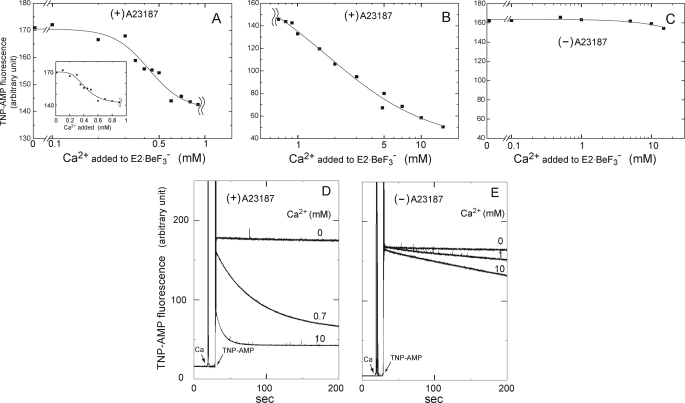FIGURE 10.
Formation of E1Ca2·BeF3− from E2·BeF3− by lumenal Ca2+ binding. E2·BeF3− was first produced in SR vesicles with BeFx in the presence and absence of 1.2 μm A23187 at 25 °C in 0.5 mm EGTA, 15 mm MgCl2, 0.1 m KCl, and 30 mm MOPS/Tris (pH 7.0). Then a small volume of CaCl2 was added to give various Ca2+ concentrations as indicated. At 10 s after this Ca2+ addition, TNP-AMP fluorescence was monitored with 4 μm TNP-AMP. In A and B, the maximum intensity in the presence of A23187 was plotted in semi-log scale at 0–0.9 mm Ca2+ (A) and 0.7–15 mm Ca2+ (B). Note also the different scales in the ordinates. The inset in A is the linear plot at 0–0.9 mm Ca2+ to clearly show the saturation of the first phase of the Ca2+-dependent change, i.e. the formation of E1Ca2·BeF3− from E2·BeF3−. In C, the maximum superfluorescence intensity in the absence of A23187 was plotted at 0–15 mm Ca2+. In D and E, the traces of superfluorescence development upon TNP-AMP addition in the presence of A23187 (D) or its absence (E) were shown at the representative Ca2+ concentrations (0, 0.7 or 1.0, and 10 mm). Solid lines in A and B show the least squares fit to the Hill equation. Apparent Ca2+ affinity (K0.5) and Hill coefficients at 0–0.9 mm Ca2+ are 0.43 mm and 3.8 with the intensity decrease from 170 to 142, and those at Ca2+ over 0.7 mm are 1.7 mm and 1.0 with a further intensity decrease to 36.

